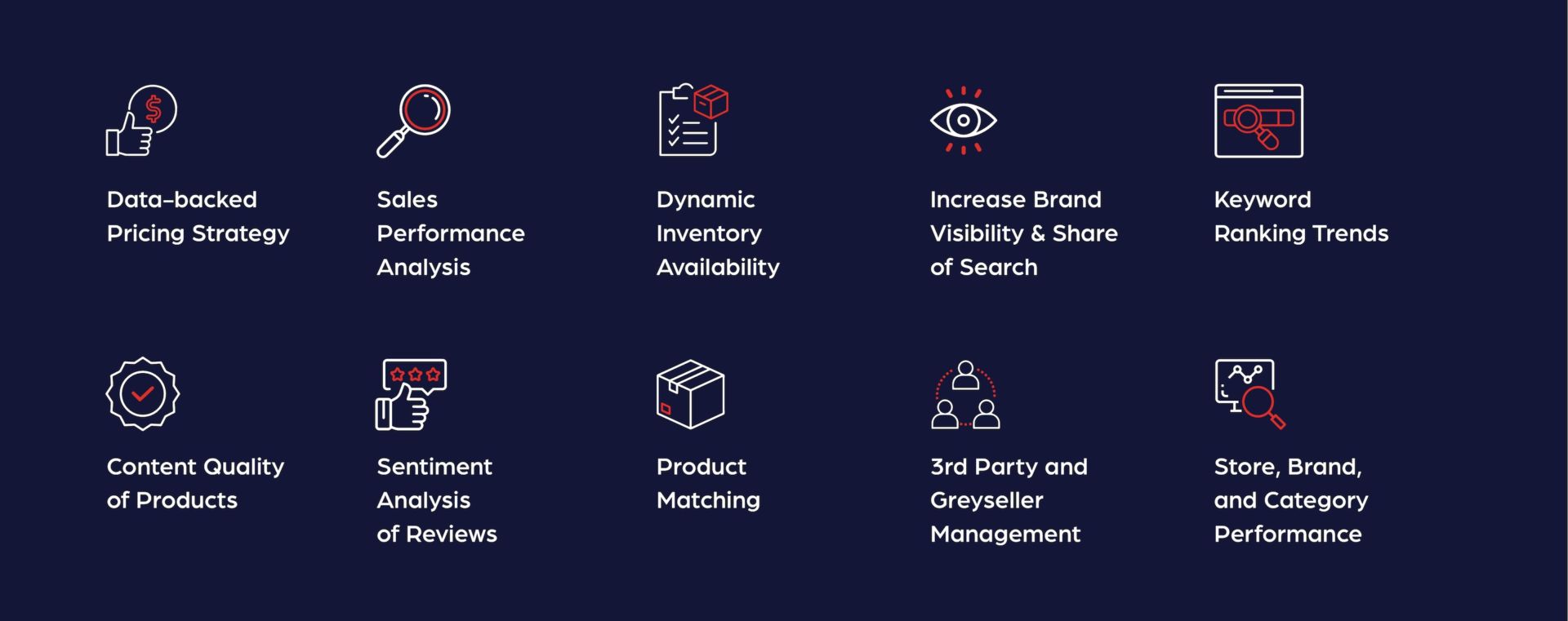
Mastering the Digital Shelf: Key capabilities that brands must have
Monitoring the health of the digital shelf has become paramount for brands operating in the online marketplace. Consumers heavily rely on digital channels for their shopping needs and having a comprehensive understanding of your online presence and performance is essential. This blog highlights key capabilities that brands must have to optimize their digital shelf strategy and achieve success.
1. Data-backed Pricing Strategy:
Accurate pricing is a crucial aspect of the digital shelf. Brands need real-time insights into competitor prices and market trends, enabling them to make informed pricing decisions. Access to insights such as underpriced & overpriced products or price history of competitors can directly impact a brand’s business. By monitoring pricing dynamics, they can remain competitive while maximizing profitability and ensuring price consistency across various online channels.
2. Sales Performance Analysis:
Understanding sales performance is vital for brands seeking growth opportunities, especially if they sell through a distribution network and have to deal with several resellers and 3rd parties. Hence, a platform that provides detailed metrics on units sold, Gross Merchandise Value (GMV), and revenue is essential.
3. Dynamic Inventory Availability:
Maintaining product availability is key to meeting customer expectations and maximizing sales. Brands should monitor inventory levels across multiple online retailers to have real-time visibility into stock availability. By proactively addressing supply chain issues and avoiding stockouts, brands can enhance customer satisfaction and drive revenue.
4. Increase Brand Visibility & Share of Search:
The share of search indicates a brand’s visibility and market share in online search results. Comprehensive data on the keywords consumers use to find products in a specific category is another key capability that a brand’s digital shelf health platform must have. Through this, brands can optimize their marketing efforts by identifying popular search terms and improving their search engine rankings, thus increasing their share of search.
5. Keyword Ranking Trends:
Monitoring keyword rankings allows brands to assess their organic visibility on search engine results pages. They need a platform that tracks the performance of brand-specific and category-related keywords. By analyzing keyword rankings, brands can identify areas for search engine optimization (SEO) improvement, enhance their online visibility, and attract more organic traffic.
6. Content Quality of Products:
Compelling and accurate product content is crucial for driving conversions and improving the customer experience. It is important to evaluate the quality of product listings, including images, descriptions, and specifications. Brands can identify content gaps, inconsistencies, or outdated information, ensuring their products are represented accurately across all online channels, thereby increasing customer trust and engagement.
7. Sentiment Analysis of Reviews:
Harnessing customer feedback is essential for brands to make data-driven decisions. A good digital shelf health platform utilizes sentiment analysis to evaluate customer reviews and identify emerging trends. By understanding customer sentiments, brands can uncover strengths and weaknesses, address concerns, and improve product offerings to enhance customer satisfaction.
8. Product Matching:
Brands should ensure that the Digital Shelf Health platform they choose provides them the capability of discovering competing products and competitors. Through AI-driven technology, you can analyze product attributes and similarities and gain significant insights into your competitive landscape. This information empowers brands to refine their positioning strategies, differentiate their offerings, and capitalize on market opportunities.
9. 3rd Party and Greyseller Management:
Managing third-party sellers is critical to maintaining brand integrity and protecting reputation. A savvy Digital Shelf Health platform should also offer comprehensive management of official resellers, grey sellers, and competitors. Brands can monitor seller activities, ensure compliance with brand guidelines, and take proactive measures to mitigate unauthorized sales , price violations, and maintain a consistent brand image.
10. Store, Brand, and Category Performance:
Knowing the best or worst performing store, brand, and category at any given time is critical information for all brands. Make sure to track key metrics such as sales, customer reviews, and search rankings. By analyzing performance data, brands can identify growth areas, optimize their digital shelf strategy, and align their efforts with consumer preferences to drive overall success.
In conclusion, effective monitoring and optimization of the digital shelf are essential for brands navigating the online marketplace. This blog has highlighted key capabilities that empower brands to succeed in the digital landscape. From pricing and sales analysis to content quality evaluation and competitor analysis, these capabilities enable brands to make informed decisions, enhance customer experiences, and drive revenue growth. By leveraging advanced analytics and AI-driven technology, brands can achieve digital shelf excellence and establish a strong online presence in today’s competitive marketplace.












